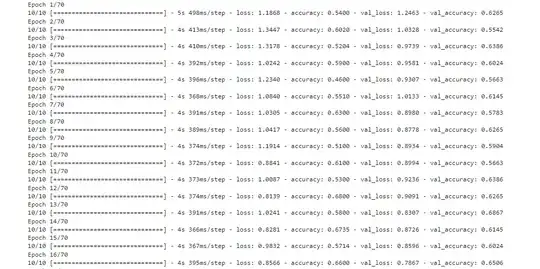I am trying to retrain ResNet-50 for iris flower classification in tensorflow (TensorFlow version: 2.3.0) using the following code
import tensorflow as tf
import cv2, random
from sklearn.model_selection import train_test_split
from sklearn.metrics import classification_report
from random import shuffle
from IPython.display import SVG
import numpy as np # linear algebra
import pandas as pd
import shutil
import matplotlib.pyplot as plt
%matplotlib inline
from IPython.display import Image, display
from sklearn.model_selection import train_test_split
import os
print(os.listdir("./iris recognition/flowers"))
labels = os.listdir("./iris recognition/flowers")
num_classes = len(set(labels))
IMAGE_SIZE= 224
Create model
model = tf.keras.Sequential()
model.add(tf.keras.applications.ResNet50(include_top=False, weights='imagenet'))
model.add(tf.keras.layers.GlobalAveragePooling2D())
model.add(tf.keras.layers.Dropout(0.5))
model.add(tf.keras.layers.Dense(num_classes, activation='softmax'))
Do not train first layer (ResNet) as it is already pre-trained
model.layers[0].trainable = False
Compile model
from tensorflow.python.keras import optimizers
sgd = optimizers.SGD(lr = 0.01, decay = 1e-6, momentum = 0.9, nesterov = True)
model.compile(optimizer='adam', loss='categorical_crossentropy', metrics=['accuracy'])
model.summary()
train_folder = './iris recognition/flowers'
image_size = 224
data_generator = tf.keras.preprocessing.image.ImageDataGenerator(preprocessing_function=tf.keras.applications.resnet50.preprocess_input,
horizontal_flip=True,
width_shift_range=0.2,
height_shift_range=0.2,
validation_split=0.2)# set validation split
train_generator = data_generator.flow_from_directory(
train_folder,
target_size=(image_size, image_size),
batch_size=10,
class_mode='categorical',
subset='training'
)
validation_generator = data_generator.flow_from_directory(
train_folder,
target_size=(image_size, image_size),
batch_size=10,
class_mode='categorical',
subset='validation'
)
NUM_EPOCHS = 70
EARLY_STOP_PATIENCE = 5
from tensorflow.python.keras.callbacks import EarlyStopping, ModelCheckpoint
cb_early_stopper = EarlyStopping(monitor = 'val_loss', patience = EARLY_STOP_PATIENCE)
cb_checkpointer = ModelCheckpoint(filepath = './working/best.hdf5',
monitor = 'val_loss',
save_best_only = True,
mode = 'auto')
import math
fit_history = model.fit(
train_generator,
steps_per_epoch=10,
validation_data=validation_generator,
validation_steps=10,
epochs=NUM_EPOCHS,
callbacks=[cb_checkpointer, cb_early_stopper])
model.load_weights("./working/best.hdf5")
I tried to change the number of epochs , steps_per_epoch and validation_steps however the model accuracy does not improved as shown in 

After trying several essais while changing batch size from 32, 64 and 128.For each essai I tried with and without using :
steps_per_epoch=10.
sgd = optimizers.SGD(lr = 0.01, decay = 1e-6, momentum = 0.9, nesterov = True)
The best accuracy I achieved is 72.29% in which the training was the most stable which was when using batch size=128 as shwon in 
Any suggestions please?!